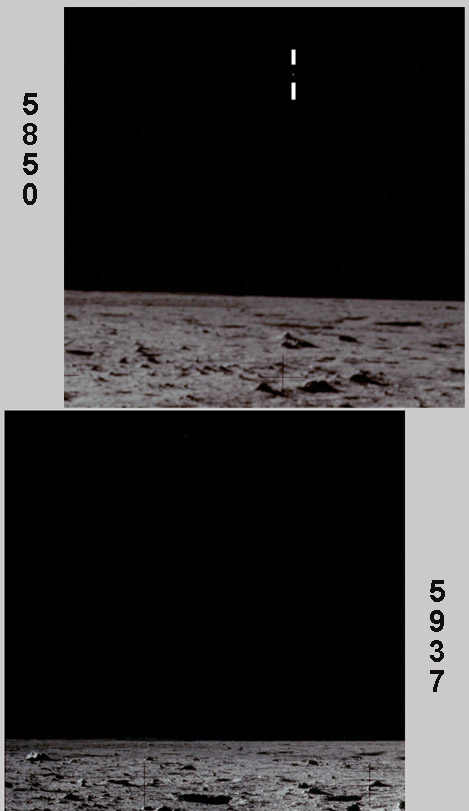
Photographing Stars
Last revised 26 May 2009.

Sky and Telescope Senior Editor Dennis di Cicco writes, "Sirius and a few other bright stars might actually be bright enough to have recorded on the exposures, but the images would be impossibly small and hard to find on the original negatives. Furthermore, when such a negative was printed to show the foreground properly, it certainly would not have shown the star(s)" di Cicco notes that it would be easy to perform such an experiment on Earth. "Go out at night with a similar setup used for the lunar photos and take a similar exposure of bright stars. Develop the film and see if you can find any star images. Then, have the negative printed with an exposure that would be proper for a normally exposed daylight negative. I am confident that you'll never, ever see a star on the print!"
Journal Contributor Markus Mehring writes, "Just to follow up on this, in theory, you'd have a better chance to spot stars on b/w photos than on color photos, since the b/w film has a wider contrast range (which was one reason why it was used so much, the other reason being its superior sharpness). But Dennis is, of course, perfectly right; while the light from a star would certainly suffice to have a chemical effect on the film emulsion, you'd never be able to see this if the film is developed regularly. If you wanted to see those stars, you'd need to pull up the contrast so much during development of the film that the objects of interest on the Moon - astronauts, rocks, mountains - would be totally overexposed. And this is, of course, never done, since these are the objects of interest in these photos." Science writer James Oberg recently called my attention to an experiment he conducted in 1979, similar to the one di Ciccio describes above. Oberg writes, "Here are two images I made in 1979 as an experiment in response to Bill Kaysing's first book on the 'Apollo Hoax', where he asked about the stars. I set up my camera on a tripod outside under a bright streetlight, took one shot with an exposure to capture me (about 1/4 second), then took a second one with a 30-sec exposure to capture the stars which had been behind me all the time, but simply hadn't registered in the illuminated scene. Anybody can perform this experiment and thereby get the answer to the phony question, 'Where are the stars?"
December 2002
Note added in June 2008: After the Sun and Earth, the next brightest object in the lunar sky is the planet Venus, which is between 10 and 20 times brighter than the brightest start, Sirius, depending on the relative locations of the Moon and Venus. Journal Contributor Danny Ross notes that Venus can be found in a series of nine Apollo 14 photographs taken by Al Shepard; and Journal Contributor Dominique Caudron notes that Charlie Duke caught Venus, in three frames from his Apollo 16 Station 10 Prime panorama. Note added in April 2006, revised June 2008: Journal Contributor Don Clark calls attention to the existence of star-like white spots in some of the scans that can be mistaken for stellar images.
An example can be seen in a detail (top half, below) from the NASA Johnson high-resolution scan from original film of AS11-40-5850, the first Hasselblad image taken during the EVA.
Because these star-like white spots are probably the result of stray bits of dust on the film or the scanner bed at the time the film was scanned, another image showing the same part of the lunar sky should not have a spot in the same location. Positive identification of Venus in the Apollo 14 and Apollo 16 photographs depended on the appearance of the planet's image at the proper location in sequences of frames.
Although the later crews were careful to provide considerable overlap of adjacent images in a pan, Neil's first pan includes only nine images with very little overlap. However, 5850 is a view roughly toward the ESE and, as part of a later pan Neil took from about 20 meters southeast of the LM while Buzz was offloading the EASEP packages, frame AS11-40-5937 gives an unimpeded view in the same direction.
Because of the offset between the two pan locations, the foregrounds in 5850 and in 5937 differ considerably. However, features just below the apparent horizon can be lined up with confidence. The resulting comparison shows that, as expected, there is no star-like spot near the location of the one in 5850 and, therefore, that the latter is not a stellar image.
A further example is provided by a star-like spot just above and to the left of the flag in AS11-40-5874. Neil shot AS11-40-5875 seconds later without changing his position or aim by any signficant amount. It contains no star-like spot near the location of the one in 5874.
